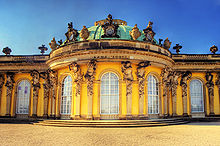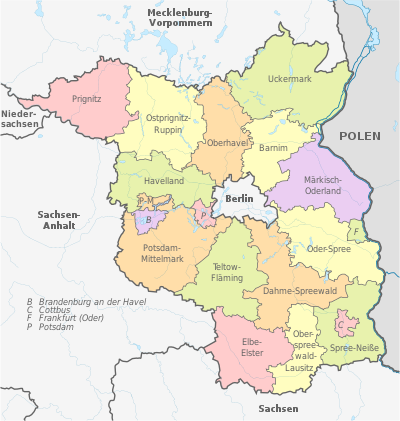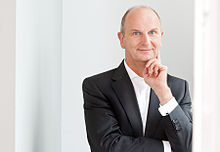Brandenburg
State of Brandenburg
Land Brandenburg ( | ||
|---|---|---|
|
NUTS Region DE4 | | |
| HDI (2018) | 0.923[4] very high · 14th of 16 | |
| Website | brandenburg.de | |
Brandenburg,
Brandenburg surrounds the national capital and city-state of Berlin, and together they form the Berlin/Brandenburg Metropolitan Region, the third-largest metropolitan area in Germany with a total population of about 6.2 million.[5] There was an unsuccessful attempt to unify both states in 1996 and the states cooperate on many matters to this day.
Brandenburg originated in the Northern March in the 900s AD, from areas conquered from the Wends. It later became the Margraviate of Brandenburg, a major principality of the Holy Roman Empire. In the 15th century, it came under the rule of the House of Hohenzollern, which later also became the ruling house of the Duchy of Prussia and established Brandenburg-Prussia, the core of the later Kingdom of Prussia. From 1815 to 1947, Brandenburg was a province of Prussia.
Following the
The origin of the name Brandenburg is believed to be West Slavic brani boru, meaning 'defensive forest'.[citation needed]
History
| History of Brandenburg and Prussia |
|---|
  |
|
| Present |
|
In late medieval and early modern times, Brandenburg was one of seven
Early Middle Ages
Brandenburg is situated in territory known in antiquity as
Beginning in the early 10th century,
Late Middle Ages

During the 12th century, the German kings and emperors re-established control over the mixed Slav-inhabited lands of present-day Brandenburg, although some Slavs like the
In 1134, in the wake of a German
In 1320, the Brandenburg Ascanian line came to an end, and from 1323 up until 1415 Brandenburg was under the control of the
16th and 17th centuries

Brandenburg converted to Protestantism in 1539 in the wake of the
Beginning near the end of that devastating conflict, however, Brandenburg enjoyed a string of talented rulers who expanded their territory and power in Europe. The first of these was
Kingdom of Prussia and German Empire


When Frederick William died in 1688, he was followed by his son Frederick, third of that name in Brandenburg. As the lands that had been acquired in Prussia were outside the boundaries of the Holy Roman Empire, Frederick assumed (as Frederick I) the title of "King in Prussia" (1701). Although his self-promotion from margrave to king relied on his title to the Duchy of Prussia, Brandenburg was still the most important portion of the kingdom. However, this combined state is known as the Kingdom of Prussia.
Brandenburg remained the core of the Kingdom of Prussia, and it was the site of the kingdom's capitals, Berlin and Potsdam. When Prussia was subdivided into provinces in 1815, the territory of the Margraviate of Brandenburg became the
East Germany

After the foundation of
(the lowest grade of coal) as an energy source, and lignite strip mines marred areas of south-eastern Brandenburg. The industrial towns surrounding Berlin were important to the East German economy, while rural Brandenburg remained mainly agricultural.Federal Republic of Germany
The present State of Brandenburg was re-established on 3 October 1990 upon German reunification.[10] The newly elected Landtag of Brandenburg first met on 26 October 1990.[11] As in other former parts of East Germany, the lack of modern infrastructure and exposure to West Germany's competitive market economy brought widespread unemployment and economic difficulty. In the recent years, however, Brandenburg's infrastructure has been modernized and unemployment has slowly declined.
Berlin-Brandenburg fusion attempt

The legal basis for a combined state of Berlin and Brandenburg is different from other state fusion proposals. Normally, Article 29 of the Basic Law stipulates that states may only merge after a specific federal Act of Parliament is enacted.[12] However, a clause added to the Basic Law in 1994, Article 118a, allows Berlin and Brandenburg to unify without federal approval, requiring a referendum and a ratification by both state parliaments.[13]
In 1996, an attempt of unifying the states of Berlin and Brandenburg was rejected at referendum.[14] Both share a common history, dialect and culture and in 2020, over 225,000 residents of Brandenburg commute to Berlin. The fusion had the near-unanimous support by a broad coalition of both state governments, political parties, media, business associations, trade unions and churches.[15] Though Berlin voted in favor by a small margin, largely based on support in former West Berlin, Brandenburg voters disapproved of the fusion by a large margin.[16] It failed largely due to Brandenburg voters not wanting to take on Berlin's large and growing public debt and fearing losing identity and influence to the capital.[14]
Geography
Brandenburg is bordered by
The
Protected areas
Brandenburg is known for its well-preserved natural environment and its ambitious natural protection policies which began in the 1990s. 15 large protected areas were designated following Germany's reunification. Each of them is provided with state-financed administration and a park ranger staff, who guide visitors and work to ensure nature conservation. Most protected areas have visitor centers.
National parks
- Lower Oder Valley National Park (106 km2)
Biosphere reserves
- SpreewaldBiosphere Reserve (474 km2 or 183 sq mi)
- Schorfheide-Chorin Biosphere Reserve (1,291 km2 or 498.46 sq mi)
- River Landscape Elbe-Brandenburg Biosphere Reserve (533 km2 or 206 sq mi)
Nature parks
- Barnim Nature Park (750 km2 or 290 sq mi)
- Dahme-Heideseen Nature Park (594 km2 or 229 sq mi)
- High Fläming Nature Park (827 km2 or 319 sq mi)
- Märkische Schweiz Nature Park (204 km2 or 79 sq mi)
- Niederlausitzer HeidelandschaftNature Park (490 km2 or 189 sq mi)
- Niederlausitzer Landrücken Nature Park(580 km2 or 224 sq mi)
- Nuthe-Nieplitz Nature Park (623 km2 or 241 sq mi)
- Schlaube Valley Nature Parke(225 km2 or 87 sq mi)
- Uckermark Lakes Nature Park (895 km2 or 346 sq mi)
- Westhavelland Nature Park (1,315 km2 or 507.72 sq mi)
- Stechlin-Ruppiner Land Nature Park (1,080 km2 or 416.99 sq mi)
Demographics
This section needs expansion. You can help by adding to it. (May 2020) |
Brandenburg has the

Development

|
|
|
Religion
17.1% of the Brandenburgers are registered members of the local, regional
Foreign population
| Nationality | Population (Dec 2020) |
|---|---|
| 35,275 | |
| 28,160 | |
| 18,345 | |
| 11,405 | |
| 9,585 | |
| 8,715 | |
| 6,425 | |
| 5,120 | |
| 3,760 | |
| 3,075 |
Politics
Politically, Brandenburg is a stronghold of the
On a federal level, the Social Democratic Party has also been the strongest party in most federal elections, their strongholds being the northwestern part of the state and Potsdam and its surrounding areas. However, the Christian Democratic Union won the most votes in 1990, their 2013 landslide and in 2017. In 2009, The Left won the most votes in a year where, like in 2017, the Social Democratic collapsed. Prominent politicians from Brandenburg include Social Democrats Frank-Walter Steinmeier, who served in the Bundestag for Brandenburg before being elected President of Germany, and likely Chancellor of Germany Olaf Scholz, who sits in the Bundestag for Potsdam.
Like in all other New states of Germany, the populist parties The Left and, more recently, the Alternative for Germany are especially strong in Brandenburg.
Brandenburg has 4 out of 69 votes in the Bundesrat and, as of 2021, 25 seats out of 736 in the Bundestag.
Subdivisions
Brandenburg is divided into 14 rural districts (Landkreise) and four urban districts (kreisfreie Städte), shown with their population in 2011:[20]

| District | Population |
|---|---|
| 176,953 | |
| 161,556 | |
| 110,291 | |
| 155,226 | |
| 189,673 | |
| 203,508 | |
| 120,023 | |
| 182,798 | |
| 102,108 | |
| 205,678 | |
| 80,872 | |
| 124,662 | |
| 161,546 | |
| 128,174 | |
| 71,534 | |
| 102,129 | |
| 60,002 | |
| 158,902 |
Government


The most recent election took place on 1 September 2019. A coalition government was formed by the Social Democrats, The Greens, and the Christian Democratic Union led by incumbent Minister-President Dietmar Woidke (SPD), replacing the previous coalition between the Social Democrats and The Left.[21] The next ordinary state election will likely occur in autumn 2024.[22]

| ||||||||
| Party | Votes | % | +/- | Seats | +/- | Seats % | ||
|---|---|---|---|---|---|---|---|---|
| Social Democratic Party (SPD) | 331,238 | 26.2 | 25 | 28.4 | ||||
| Alternative for Germany (AfD) | 297,484 | 23.5 | 23 | 26.1 | ||||
| Christian Democratic Union (CDU) | 196,988 | 15.6 | 15 | 17.0 | ||||
| Alliance 90/The Greens (Grüne) | 136,364 | 10.8 | 10 | 11.4 | ||||
| The Left (Linke) | 135,558 | 10.7 | 10 | 11.4 | ||||
| Brandenburg United Civic Movements/Free Voters (BVB/FW) | 63,851 | 5.05 | 5 | 5.7 | ||||
| Free Democratic Party (FDP) | 51,660 | 4.1 | 0 | ±0 | 0 | |||
| Human Environment Animal Protection | 32,959 | 2.6 | 0 | ±0 | 0 | |||
| Pirate Party Germany (Piraten) | 8,712 | 0.7 | 0 | ±0 | 0 | |||
| Others | 10,292 | 0.8 | 0 | ±0 | 0 | |||
| Total | 1,265,106 | 100.0 | 88 | ±0 | ||||
| Voter turnout | 61.3 | |||||||
Economy
The Gross domestic product (GDP) of the state was 72.9 billion euros in 2018, accounting for 2.2% of German economic output. GDP per capita adjusted for purchasing power was 26,700 euros or 88% of the EU27 average in the same year. The GDP per employee was 91% of the EU average. The GDP per capita was the third lowest of all states in Germany.[23]
The unemployment rate stood at 5.6% in November 2022 and was higher than the German average but lower than the average of Eastern Germany.[24]
| Year[25] | 2000 | 2001 | 2002 | 2003 | 2004 | 2005 | 2006 | 2007 | 2008 | 2009 | 2010 | 2011 | 2012 | 2013 | 2014 | 2015 | 2016 | 2017 | 2018 | 2019 | 2020 | 2021 |
|---|---|---|---|---|---|---|---|---|---|---|---|---|---|---|---|---|---|---|---|---|---|---|
| Unemployment rate in % | 17.0 | 17.5 | 17.5 | 18.8 | 18.7 | 18.2 | 17.0 | 14.7 | 13.0 | 12.3 | 11.1 | 10.7 | 10.2 | 9.9 | 9.4 | 8.7 | 8.0 | 7.0 | 6.3 | 5.8 | 6.3 | 5.9 |
Tesla Gigafactory Berlin-Brandenburg is located in Brandenburg.
Transport
. In 2016, Schönefeld handled 11,652,922 passengers (an increase of 36.7%).Schönefeld's existing infrastructure and terminals were incorporated into the new Berlin Brandenburg Airport (BER),[26] which opened in 2020.[27] Berlin Brandenburg Airport had an initial capacity of 35–40 million passengers a year. Due to increasing air traffic in Berlin and Brandenburg, plans for airport expansions were in the making.
Berlin Brandenburg Airport receives over sixty combined passenger, charter and cargo airlines.
Education and research
This section needs expansion. You can help by adding to it. (May 2020) |
Higher education

In 2016, around 49,000 students were enrolled in Brandenburg universities and higher education facilities.
Universities in Brandenburg:
- University of Potsdam
- Brandenburg University of Technology in Cottbus and Senftenberg
- European University Viadrina in Frankfurt (Oder)
- Konrad Wolf Film University of Babelsberg
- Medizinische Hochschule Brandenburg Theodor Fontane
Culture
Music
The
Cuisine

A famous speciality food from Brandenburg are the
Notable people
- Wilhelm von Humboldt (1767–1835), philosopher, linguist, diplomat, and founder of the Humboldt University of Berlin
- Heinrich von Kleist (1777–1811), poet, dramatist, and novelist
- Karl Friedrich Schinkel (1781–1841), architect, city planner, and painter
- Peter Joseph Lenné (1789–1866), gardener and landscape architect
- Theodor Fontane (1819–1898), novelist and poet
- Wilhelm Pieck (1876–1960), politician, first President of the German Democratic Republic
- Kurt Demmler (1943–2009), songwriter; accused of sexual abuse he hanged himself in his jail cell.
- Wolfgang Joop (born 1944), fashion designer, founder of JOOP!
- Matthias Platzeck (born 1953), politician, Minister President of Brandenburg from 2002 to 2013
- Henry Maske (born 1964), professional boxer
- Paul van Dyk (born 1971), DJ, record producer, and musician
- Britta Steffen (born 1983), competitive swimmer, former Olympic, World, and European champion
- Robert Harting (born 1984), discus thrower, former Olympic, World, and European champion
- Roehl brothers, Washington state.
- Mike David Ortmann (born 1999), racing driver
See also
Notes
References
- Amt für Statistik Berlin-Brandenburg (in German). 2019. Archived(PDF) from the original on 9 October 2022. Retrieved 23 May 2020.
- ^ "Bruttoinlandsprodukt, Bruttowertschöpfung | Statistikportal.de". Statistische Ämter des Bundes und der Länder | Gemeinsames Statistikportal (in German). Retrieved 31 July 2023.
- ^ BP = Brandenburg Province, SB = Soviet Zone, Brandenburg. With the abolition of states in East Germany in 1952 vehicle registration followed the new Bezirk subdivisions. Since 1991 distinct prefixes are specified for each district.
- ^ "Sub-national HDI – Area Database – Global Data Lab". hdi.globaldatalab.org. Retrieved 13 September 2018.
- ^ "Berlin-Brandenburg | IKM". 31 August 2020.
- ISBN 0-8014-3977-9.
- ^ Institut für Sorbische Volksforschung in Bautzen (1962). Lětopis Instituta za serbski ludospyt. Bautzen: Domowina.
- ISBN 0-7864-2248-3.
- ^ Chisholm, Hugh, ed. (1911). . Encyclopædia Britannica. Vol. 3 (11th ed.). Cambridge University Press. p. 778.
- ^ "Ländereinführungsgesetz (1990)" (in German). Archived from the original on 29 May 2004.
- ^ "Historischer Kalender - 20 Jahre Land Brandenburg". Archived from the original on 11 April 2010. Retrieved 26 October 2010.
- ^ "Grundgesetz für die Bundesrepublik Deutschland" [Basic Law for the Federal Republic of Germany]. Article 29, of 24 May 1949 (in German). Parlamentarischer Rat.
- ^ "Grundgesetz für die Bundesrepublik Deutschland" [Basic Law for the Federal Republic of Germany]. Einzelnorm 118a, of 27 October 1994 (in German). Bundestag.
- ^ a b "LÄNDERFUSION / FUSIONSVERTRAG (1995)". 2004. Retrieved 31 March 2022.
- ^ "Die Brandenburger wollen keine Berliner Verhältnisse". Tagesspiegel (in German). 4 May 2016. Retrieved 30 March 2022.
- ^ Barry, Colleen (6 May 1996). "Eastern Voters Block Merger With Berlin". AP News. Retrieved 4 January 2022.
- ^ Detailed data sources are to be found in the Wikimedia Commons.Population Projection Brandenburg at Wikimedia Commons
- ^ a b Die kleine Brandenburg–Statistik 2011. Amt für Statistik Berlin-Brandenburg. Archived 24 August 2012 at the Wayback Machine
- ^ [1] 31 December 2014 German Statistical Office. Zensus 2014: Bevölkerung am 31. Dezember 2014
- ^ "Amt für Statistik Berlin Brandenburg – Statistiken". www.statistik-berlin-brandenburg.de (in German). Archived from the original on 8 March 2021. Retrieved 24 April 2015.
- ^ SPIEGEL, DER (20 November 2019). "Dietmar Woidke in Brandenburg als Ministerpräsident wiedergewählt – DER SPIEGEL – Politik". Der Spiegel (in German). Retrieved 11 January 2021.
- ^ "Bundesrat – Election dates in the federal states". www.bundesrat.de. Retrieved 11 January 2021.
- ^ "Regional GDP per capita ranged from 30% to 263% of the EU average in 2018". Eurostat. Archived from the original on 9 October 2022.
- ^ "Arbeitslosenquote nach Bundesländern in Deutschland 2018 | Statista". Statista (in German). Retrieved 13 November 2018.
- ^ (Destatis), © Statistisches Bundesamt (13 November 2018). "Federal Statistical Office Germany – GENESIS-Online". www-genesis.destatis.de. Retrieved 13 November 2018.
- ^ "The future lies in Schoenefeld". Berlin-airport.de. Archived from the original on 2 May 2011.
- ^ "The BER will remain ghost-airport until 2020", welt.de, 15. December 2017
- ^ "Dateien". www.statistischebibliothek.de. Retrieved 6 March 2021.
- ^ "Brandenburg auf dem Sprung zu 2,5 Millionen-Einwohner-Marke". Archived from the original on 13 January 2017. Retrieved 12 January 2017.
- ^ Johann Sebastian Bach's Werke, vol.19: Kammermusik, dritter band, Bach-Gesellschaft, Leipzig; ed. Wilhelm Rust, 1871
- ISBN 0-312-27266-9
- ^ "Germany's Spreewald gherkins – possibly the best in the world". The Guardian. 10 July 2016. Retrieved 9 May 2020.
External links
- Official website (in English)
- Official local information system (in English)
- Brandenburg Tourist Board (in English)
 Geographic data related to Brandenburg at OpenStreetMap
Geographic data related to Brandenburg at OpenStreetMap

